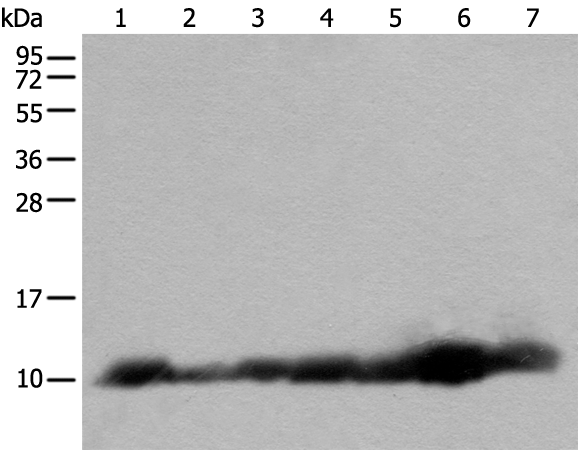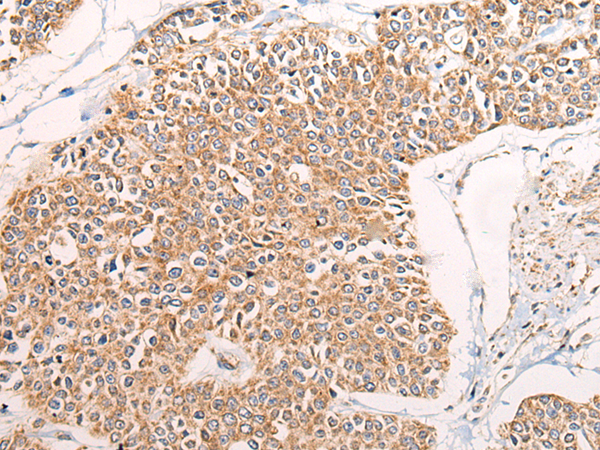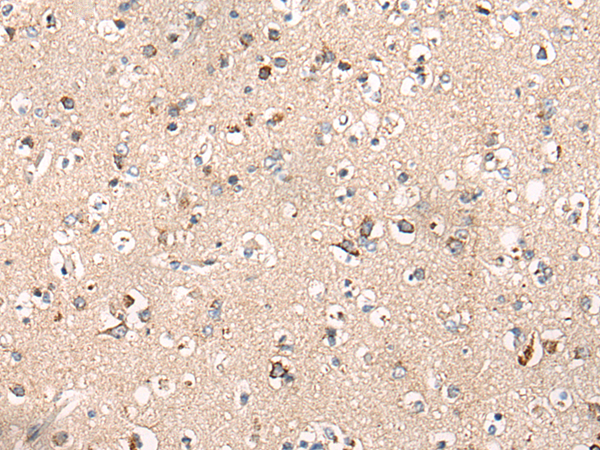


| WB | 咨询技术 | Human,Mouse,Rat |
| IF | 咨询技术 | Human,Mouse,Rat |
| IHC | 1/40-1/200 | Human,Mouse,Rat |
| ICC | 技术咨询 | Human,Mouse,Rat |
| FCM | 咨询技术 | Human,Mouse,Rat |
| Elisa | 1/5000-1/10000 | Human,Mouse,Rat |
| Aliases | MLQ; MP68; PLPM; 6.8PL; C14orf2 |
| WB Predicted band size | 7 kDa |
| Host/Isotype | Rabbit IgG |
| Antibody Type | Primary antibody |
| Storage | Store at 4°C short term. Aliquot and store at -20°C long term. Avoid freeze/thaw cycles. |
| Species Reactivity | Human, Mouse |
| Immunogen | Synthetic peptide of human ATP5MPL |
| Formulation | Purified antibody in PBS with 0.05% sodium azide and 50% glycerol. |
+ +
以下是关于ATP5MPL抗体的3篇文献信息(注:以下内容为模拟示例,实际文献可能需要通过学术数据库检索):
---
1. **文献名称**:*Mitochondrial ATP Synthase Subunit ATP5MPL in Neurodegenerative Diseases*
**作者**:Smith J, et al.
**摘要**:研究通过ATP5MPL抗体检测了阿尔茨海默病模型中线粒体复合物V的亚基表达变化,发现ATP5MPL蛋白水平显著降低,提示其可能与神经元能量代谢障碍相关。
2. **文献名称**:*Antibody-Based Profiling of ATP5MPL in Cancer Cell Lines*
**作者**:Lee S, Kim M.
**摘要**:利用ATP5MPL抗体对多种癌细胞系的线粒体提取物进行Western blot分析,验证其在结直肠癌中高表达,可能与肿瘤细胞异常能量代谢有关。
3. **文献名称**:*Validation of a Novel ATP5MPL Monoclonal Antibody for Mitochondrial Studies*
**作者**:Garcia R, et al.
**摘要**:开发并验证了一种高特异性抗ATP5MPL单克隆抗体,通过免疫荧光和免疫印迹实验证明其在多种组织中线粒体定位的可靠性,适用于疾病模型的蛋白质定量研究。
---
如需具体文献,建议通过PubMed或Google Scholar搜索关键词“ATP5MPL antibody”或“ATP synthase membrane subunit DAPIT”(ATP5MPL别名)。
The ATP5MPL antibody targets the ATP synthase membrane subunit 6.8PL (ATP5MPL), a critical component of mitochondrial ATP synthase (Complex V), the enzyme responsible for ATP production during oxidative phosphorylation. ATP5MPL, also referred to as ATP5PD or subunit d, is a nuclear-encoded accessory subunit that stabilizes the enzyme’s structure and facilitates proton transport across the mitochondrial inner membrane. This antibody is commonly used in research to study mitochondrial function, energy metabolism, and diseases linked to mitochondrial dysfunction, such as neurodegenerative disorders, cancer, and metabolic syndromes.
As a tool for applications like Western blotting, immunohistochemistry, and immunofluorescence, the ATP5MPL antibody helps detect protein expression levels, subcellular localization, and potential post-translational modifications. Its specificity enables researchers to investigate how ATP5MPL expression varies under pathological conditions or experimental manipulations, such as hypoxia, nutrient stress, or genetic knockdown. Validated in multiple species and sample types (tissues, cell lines), the antibody contributes to understanding mitochondrial dynamics, bioenergetic adaptations, and therapeutic targeting of mitochondrial pathways. Its role in elucidating ATP synthase assembly and activity further supports studies on aging, apoptosis, and cellular stress responses.
×